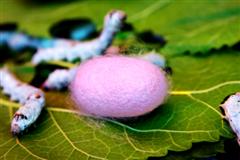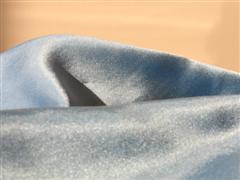|
Guilt Free With Organic SilkPure Silk Silk has a 3000 year history and has to be one of the most amazing and most beautiful of all of earth's fibers. 
It is created by the protein secretions of silkworms which solidify to create the cocoon fibers. If you were to compare fiber by fiber, this remarkable natural creation is stronger than steel. There is no question that organic silk production is the more environmentally friendly, non-violent and sustainable practice of silk cultivation. Zero chemicals or treatments are required for raw silk, which is readily biodegradable. Care What You Wear... This is an amazing phenomenon in itself, but if you were to compare fiber by fiber, this remarkable natural creation is stronger than steel. Silk fabric has always signified luxury and elegance and is today, still valued highly, dubbing it the "Queen of Fiber." These days, green silk is taking eco fashion to new heights. You can caress your body in the rich luxury of silk without feeling guilty, while still maintaining your eco values. What Is Organic Silk Organic silk (aka raw silk) is created without the use of any chemicals or treatments using insecticides, pesticides or synthetic fertilizers. The silkworms are allowed to live out their full lives and die naturally. Environmental friendliness utilizes natural and sustainable farming techniques. Of course, raw silk is biodegradable. Natural silk colors are produced but some organic silk is dyed with natural dyes. Organic Silk Benefits When blended with animal fibers, the resulting fabric may loose some of it's sheen, depending on the silk content. However, blended yarns will have improved drape and elasticity. Blends with cotton and other fibers will produce a silken sheen and added softness.
Disadvantages of Silk Clothing
Silk Fabric Care Always, always follow the garment label. Some silk fabrics can be hand washed but others cannot depending on the dye and finish used in the garment. Giving your silk clothing the proper care will freshen the fabric and prolong garment life.
Hanging in the bathroom will allow shower humidity to remove wrinkles. Environmental Benefits Organic silk farming has reaching effects by also promoting the sustainability of mulberry trees, which are the silkworms food source. One mulberry tree will feed roughly 100 silkworms. One acre of renewable trees sustains silkworm life to produce 30-35 pounds of raw silk. Highly sought after natural reddish or golden silk colors are produced, depending on the specific silkworm breed and it’s feed. These trees, in turn, provide a valuable renewable resource for local production of baskets, furniture even folk remedies. Animal Friendly?
Since the worms spin organic silk and complete their full life cycle unimpaired, these (organic, wild and natural peace) silks are often called Peace Silk or Vegetarian Peace Silk. Understanding Silk Descriptions
Cultivated Silk Conventional cultivated silk is not an animal friendly process and concerns are being raised by consumers worldwide. Sericulture is a hugely developed worldwide industry earning it's livelihood from domesticated silkworms. A few moths are allowed to emerge to breed the needed population, but most of the the cocoons are boiled or baked with the pupae inside. This process is carried out so that the silk fibers are not broken when the moth emerges from the cocoon. Broken silk fibers result in silk noil. These shorter fibers are spun into a more textured silk rather than being reeled from a continuous strand and marketed as fine silk. One pound of silk for the creation of silk clothing requires the sacrifice of about 2600 silkworms. Most often corporate silk farms utilize chemicals for higher production. Hormone disrupters which slow the growth rate and extend the silk producing time of the worms are commonly used, as well as pesticides and fertilizers. Chemical treatments are added to create wash and wear special finishing such as dyes, wrinkle reducers, anti-static properties, water repellents, etc. Ethical Silk – A Consumer Dilemma The consumer dilemma is that sometimes raw silk production is in fact organic because it has not underwent any kind of chemical intervention. However, an ethical question may arise because organic silk may not necessarily be peace silk. So it really boils down to consumer compromise between emotions and organic desires. Organic silk produced in small villages by indigenous people is the choice for the purest silk. Whatever you choose, be sure to ask about
Fair Trade prinicipals. Care What You Wear... So Where Can You Find Friendly Silk? Return from Organic Silk to Home Page
|





 Raw silk has the versatility to be blended with just about any other fiber.
Raw silk has the versatility to be blended with just about any other fiber.